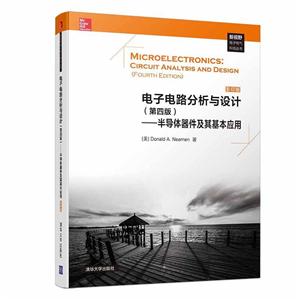Prologue I
PROLOGUETO ELECTRONICS 1
Brief History 1
Passive and Active Devices 2
Electronic Circuits 2
Discrete and Integrated Circuits 3
Analog and Digital Signals 3
Notation 4
Summary 5
Part 1
SEMICONDUCTOR DEVICES AND BASIC APPLICATIONS 7
Chapter 1 Semiconductor Materials and Diodes 9
Preview 9
1.1 Semiconductor Materials and Properties 10
1.2 The pn Junction 23
1.3 Diode Circuits: DC Analysis and Models 34
1.4 Diode Circuits: AC Equivalent Circuit 43
1.5 Other Diode Types 48
1.6 Design Application: Diode Thermometer 54
1.7 Summary 56
Problems 57
Chapter 2 Diode Circuits 67
Preview 67
2.1 Rectifier Circuits 68
2.2 Zener Diode Circuits 84
2.3 Clipper and Clamper Circuits 90
2.4 Multiple-Diode Circuits 97
2.5 Photodiode and LED Circuits 106
2.6 Design Application: DC Power Supply 108
2.7 Summary 110
Problems 111
Chapter 3 The Field-Effect Transistor 125
Preview 125
3.1 MOS Field-Effect Transistor 126
3.2 MOSFET DC Circuit Analysis 146
3.3 Basic MOSFET Applications: Switch, Digital Logic Gate,
and Amplifier 165
3.4 Constant-Current Biasing 170
3.5 Multistage MOSFET Circuits 175
3.6 Junction Field-Effect Transistor 180
3.7 Design Application: Diode Thermometer with an MOS
Transistor 190
3.8 Summary 192
Problems 194
Chapter 4 Basic FETAmplifiers 205
Preview 205
4.1 The MOSFET Amplifier 206
4.2 Basic Transistor Amplifier Configurations 216
4.3 The Common-Source Amplifier 216
4.4 The Common-Drain (Source-Follower) Amplifier 227
4.5 The Common-Gate Configuration 234
4.6 The Three Basic Amplifier Configurations: Summary
and Comparison 237
4.7 Single-Stage Integrated Circuit MOSFET
Amplifiers 238
4.8 Multistage Amplifiers 254
4.9 Basic JFETAmplifiers 258
4.10 Design Application: A Two-Stage Amplifier 264
4.11 Summary 266
Problems 268
Chapter S The Bipolar Junction Transistor 285
Preview 285
5.1 Basic Bipolar Junction Transistor 286
5.2 DCAnalysis of Transistor Circuits 301
5.3 Basic Transistor Applications 323
5.4 Bipolar Transistor Biasing 330
5.5 Multistage Circuits 344
5.6 Design Application: Diode Thermometer with a Bipolar
Transistor 348
5.7 Summary 350
Problems 352
Chapter 6 Basic BJTAmplifiers 369
Preview 369
6.1 Analog Signals and Linear Amplifiers 370
6.2 The Bipolar Linear Amplifier 371
6.3 Basic Transistor Amplifier Configurations 396
6.4 Common-Emitter Amplifiers 398
6.5 AC Load Line Analysis 413
6.6 Common-Collector (Emitter-Follower) Amplifier 420
6.7 Common-BaseAmplifier 431
6.8 The Three Basic Amplifiers: Summary
and Comparison 435
6.9 Multistage Amplifiers 436
6.10 Power Considerations 442
6.11 Design Application: Audio Amplifier 445
6.12 Summary 449
Problems 451
Chapter 7 Frequency Response 469
Preview 469
7.1 Amplifier Frequency Response 470
7.2 System Transfer Functions 472
7.3 Frequency Response: Transistor Amplifiers with Circuit
Capacitors 485
7.4 Frequency Response: Bipolar Transistor 502
7.5 Frequency Response: The FET 514
7.6 High-Frequency Response of Transistor Circuits 520
7.7 Design Application: A Two-Stage Amplifier
with Coupling Capacitors 537
7.8 Summary 539
Problems 540
Chapter 8 Output Stages and Power Amplifiers 559
Preview 559
8.1 Power Amplifiers 560
8.2 Power Transistors 560
8.3 Classes of Amplifiers 571
8.4 Class-A Power Amplifiers 586
8.5 Class-AB Push-Pull Complementary Output Stages 591
8.6 Design Application: An Output Stage Using
MOSFETs 601
8.7 Summary 603
Problems 604
Appendix A Physical Constants and Conversion Factors 615
Appendix B Selected Manufacturers' Data Sheets 617
Appendix C Standard Resistor and Capacitor Values 629
Appendix D Reading List 633
Appendix E Answers to Selected Problems 637




















